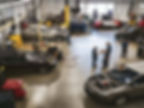Clutch Replacement Service

🕹️ Clutch Replacement — Service, Symptoms & What to Expect?

Common Symptoms for Clutch Replacement
How a Clutch Works & Why It Wears Out
Book Your Clutch Replacement Service Today

📍 Clutch Replacement Experts Near You


⚑ Close to Steeles Ave & Torbram Rd Brampton, ON L6T 1A7
✰✰✰✰✰4.8 star rating

⚑ Just off Appleby Line & Corporate Dr Burlington, ON L7L 5T9
✰✰✰✰✰4.9 star rating

⚑ Nearby Burnhamthorpe Rd & Kipling Ave Etobicoke, ON M8Z 2X3
✰✰✰✰✰4.8 star rating

⚑ Near Mohawk Rd & Upper Sherman Ave Hamilton, ON L8V 4G7
✰✰✰✰✰4.6 star rating

⚑ Near Matheson Blvd & Hurontario St Mississauga, ON L4Z 2Y5
✰✰✰✰✰4.4 star rating

⚑ Close to Finch Ave & Weston Rd North York, ON M9M 2Y3
✰✰✰✰✰4.5 star rating

⚑ Right by Howard Park Ave & Bloor St Toronto, ON M6R 1V5
✰✰✰✰✰4.7 star rating
💬 Clutch Service: FAQs

How do I know if my clutch is going bad?

Signs include difficulty shifting gears, a slipping clutch, strange noises when pressing the pedal, or a soft or stiff clutch pedal.
How long does a clutch replacement take?

Clutch replacement usually takes between 4 to 6 hours, depending on the vehicle type and the complexity of the repair.
How much does a clutch replacement cost?

Clutch replacement costs vary but generally range from $500 to $2,500, depending on the make and model of the vehicle.
Is it safe to drive with a slipping clutch?

It's not recommended to drive with a bad clutch, as it can lead to complete failure, preventing you from shifting gears safely.
What is a flywheel & is it replaced with the clutch?

A flywheel is a heavy metal disc attached to the engine’s crankshaft in manual vehicles. It works with the clutch to transfer power from the engine to the transmission and helps keep engine speed steady. While the flywheel isn’t always replaced during clutch service, it’s inspected for damage or wear. If it’s warped, cracked, or has excessive heat spots, your mechanic may recommend resurfacing or replacing it to ensure your new clutch performs smoothly and lasts longer.
How long do clutches typically last?

A clutch can last anywhere from 85,000 km to 160,000 km, depending on driving habits and conditions. However, aggressive driving or frequent stop-and-go traffic can wear it out more quickly.


